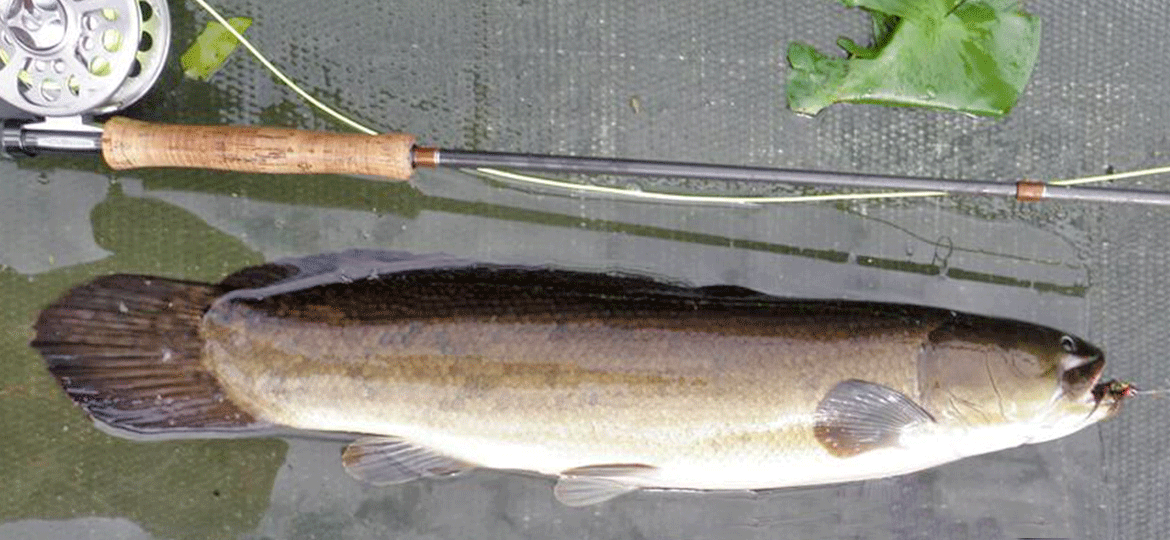
The bowfin (Amia calva) is distinguishable by their elongated, cylindrical body, large, tooth-filled mouth, and an upper jaw which extends beyond their eye. A long dorsal fin runs over half the length of their olive to green back. They exhibit a cream to pale green coloration on their body, with a large spot at the upper base on the caudal fin. The fins of spawning males may also have a greenish coloration.
Bowfin range from the St. Lawrence and Champlain drainages, through the Great Lakes drainage (except Lake Superior), and down to the Mississippi River drainage into the Gulf Coast and along the coast to Texas. They can also be found along the Atlantic Slope drainages from southern Pennsylvania to Florida. Vermont populations can be found in Lake Champlain and in the lower reaches of some of its tributaries, as well as Cedar Lake in Addison County.
Females can reach lengths up to 43 inches and often live longer than males. These fish are commonly found in the 18-to-24-inch range.
Habitat
Bowfin tend to like slow or still water in large streams and rivers, and congregate in the shoreline areas of lakes. They generally live in highly vegetated areas of clear or mildly turbid water bodies. They are exceptionally tolerant of low dissolved oxygen levels giving them the ability to live in areas where other predators are unable to survive.
Bowfin have a specialized swim bladder that allows them to absorb oxygen by gulping in air at the water surface.
Reproduction
Spawning usually commences in May into early June at water temperatures of 60 to 66°F. Males will build nests of vegetative material that are about one to two feet in diameter in shallow water. Nests are generally built near cover such as logs or stumps in shallow, heavily vegetated areas.
Males often mate with several females since females usually visit multiple nests. Females in the five-pound range can lay up to 24,000 adhesive eggs that stick on the bottom of the nest after being deposited.
Males guard and fan eggs to provide them with oxygen. Males closely guard the nest and hatchlings, even when they have reached four inches long. Young fish generally grow to five to nine inches in their first growing season. Individuals reach sexual maturity between the ages of three- and five-years-old.
Diet
Bowfin are opportunistic feeders. They feed on just about any living creature that will fit in its mouth including crayfish, insect larvae, leeches, worms, frogs, and fish. That said, they are not believed to be scavengers.
Management
This species has no minimum length but there is a five fish daily limit. Work conducted by Vermont Fish & Wildlife staff to help conserve these populations includes, but is not limited to:
- Improving aquatic organism passage.
- Protecting and restoring fish habitat.
- Monitoring local fish communities.
- Engaging in regulatory proceedings, providing direct input to protect aquatic habitats on individual development projects through Act 250, Section 248, Stream Alteration, Dam Safety, hydroelectric relicensing, water withdrawals, etc.
Status
This species is not listed as threatened or endangered and is not currently a species of greatest conservation need in Vermont.
Fun Facts
- Other common names: dogfish, mudfish, cotton fish, grinnel, speckled cat, beaver fish, swamp muskie, choupique
- The bowfin is a living dinosaur that’s been around for over 100 million years!
- Bowfin can gulp air from the surface and store it in a blood-vessel-rich gas bladder that works like a lung, allowing them to survive in poor oxygen conditions or even out of the water for short periods of time. This is what helped them survive extreme environments over the last 100 million years.
- Bowfin can swim backward as easily as they swim forward because of their elongated dorsal fin which they can ripple and manipulate to reverse direction. It also lets them effortlessly navigate dense vegetation.
- Bowfin’s tubular nostrils on top of their bony head aids in hunting prey. Their sense of smell is much better than their eyesight, which is why fishing for them with cut bait is so effective!
- The bowfin has the thickest, densest skull bones of any fish—armored like a dinosaur.
- Nearly every bone of a bowfin’s mouth is lined with wicked long, sharp, curved teeth. Scaled up to dino-dimensions, a bowfin’s teeth would rival the size any meat-eating dinosaur.
- In the spring, males develop neon green bellies and fins as a way to attract females for spawning.
- Male bowfin build circular nests in thick vegetation for females to deposit eggs into. After spawning, the female leaves and the male stays on the nest for several weeks guarding the eggs and the fry.
- The black eyespot (ocellus) on the tail is found on all juveniles, but only on males as adults. It’s thought to serve two purposes:
- as a “false eye” it can confuse or misdirect an attacking predator
- it may help young bowfin fry find and stay close to their protective father when on the nest.
